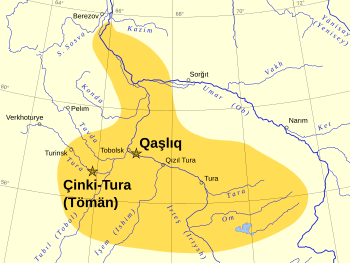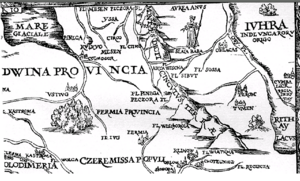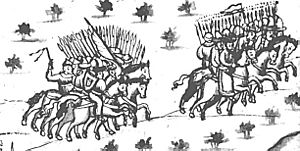Khanate of Sibir facts for kids
Quick facts for kids
Khanate of Sibir
Себер ханлыгы
|
|||||||||
|---|---|---|---|---|---|---|---|---|---|
| 1468–1598 | |||||||||

Approximate extent of the Khanate of Sibir during the fifteenth and sixteenth centuries
|
|||||||||
| Capital | Tyumen, Sibir | ||||||||
| Official languages | Chagatai language, Old Tatar | ||||||||
| Common languages | Siberian Tatar, Bashkir, Selkup, Khanty, Mansi | ||||||||
| Religion | Sunni Islam, Shamanism | ||||||||
| Government | Khanate, Kraterocracy |
||||||||
| Khan | |||||||||
|
• 1420–1428
|
Hajji Muhammad | ||||||||
|
• 1428–1468
|
Abu'l-Khayr Khan (as Uzbek Khan) | ||||||||
|
• 1468–1495
|
Ibak Khan | ||||||||
| History | |||||||||
|
• Established
|
1468 | ||||||||
|
• Abu'l-Khayr Khan becomes Khan of Sibir
|
1428 | ||||||||
|
• Ibak Khan is Khan of Sibir
|
1468 | ||||||||
|
• Conquered by the Tsardom of Russia
|
1598 | ||||||||
|
|||||||||
| Today part of | Russia | ||||||||
The Khanate of Sibir (Siberian Tatar: Себер ханлыгы, Bashkir: Себер ханлығы), also called the Siberian Yurt, was a powerful state in southwestern Siberia. It was ruled by a mix of Turkic and Mongol leaders. Two main families, the Shaybanids and the Taibugids, often fought for control. Both families were descendants of Genghis Khan, a famous Mongol leader.
This area was once part of the huge Mongol Empire. Later, it became part of the Golden Horde, another large Mongol state. The Khanate of Sibir had many different people living there. These included Siberian Tatars, Bashkirs, and groups speaking Uralic languages like the Khanty and Mansi. The Khanate of Sibir was the northernmost Muslim state ever recorded. Its defeat by Yermak Timofeyevich in 1582 marked the start of Russia taking over Siberia.
Contents
Life and Culture in Sibir
The Khanate of Sibir was led by a ruler called a Khan. Under the Khan were nobles known as Mirzas. These Mirzas came from different local Siberian tribes. They managed their own areas, but they all answered to the Khan. Mirzas also led the Khanate's warriors into battles.
Religion and Beliefs
Islam was the main religion of the Sibir Khanate. The ruling Khan and the Mirzas followed Islam. They built large mosques, palaces, and strong walls in the capital cities of Tyumen and Sibir. Many Mirzas even studied in famous Islamic learning centers in Central Asia.
However, many ordinary people also practiced Shamanism and other traditional beliefs. Some groups mixed Islam with parts of shamanism. The religious leaders of Sibir, like Imams and Muftis, were quite respected. They even had some influence in cities like Kazan and Samarkand. The Khanate of Sibir was known as the northernmost Muslim state in history.
Trade and Connections
The Khanate of Sibir was an important trading hub. It had strong trade links with Central Asia and the Kazan Khanate. This helped bring goods and ideas into the region.
History of the Khanate

The land where the Khanate of Sibir grew was first home to Samoyedic and Ugrian groups. Around the 11th century, Kipchaks moved into the area. This led to many people in the region becoming more Turkic in their culture and language. In the 13th century, the Mongols conquered the area. It then became part of the Golden Horde. Some Tatars who came with Batu Khan during the Mongol conquests settled there.
The Khanate of Sibir started in the 1400s. This was a time when the Mongol power was generally getting weaker. The first capital city of the Khans was Chimgi-Tura. The first Khan was Taibuga. He was followed by his son Khoja, and then his grandson Mar.
Rivalry for Control
The Taibugid family did not always have full control. The Shaybanids, another family descended from Genghis Khan, also wanted to rule the area. Ibak Khan, a Shaybanid, killed Mar and took control of Chimgi-Tura. But the Taibugids fought back. Mar's grandson, Muhammad, fled east and later killed Ibak around 1493. Muhammad then moved the capital from Chimgi-Tura to a new city called Iskar (also known as Sibir).
In 1552, Russia conquered the Kazan Khanate. This made the Taibugid Khan of Sibir, Yadigar, want to be friends with Moscow. However, Yadigar faced a challenge from a Shaybanid named Kuchum. Kuchum was Ibak's grandson. After several years of fighting (1556–1563), Yadigar died, and Kuchum became the new Khan.
The Russian Conquest of Sibir
Kuchum tried to make the Siberian Tatars, who mostly followed shamanism, convert to Islam. He also raided the trading posts of the Stroganov family, who were powerful Russian merchants. This led to an expedition by the Cossack leader Yermak Timofeyevich against the Khanate of Sibir.
Yermak's forces defeated Kuchum at the Battle of Chuvash Cape in 1582. The Cossacks then entered Iskar later that year. Kuchum did not give up easily. He gathered his forces again and killed Yermak in battle in 1584. Kuchum then took back control of Sibir.
However, over the next 14 years, the Russians slowly conquered the Khanate. In 1598, Kuchum was defeated near the Ob River. He was forced to flee to the lands of the Nogai Horde, which ended his rule. This marked the end of the Khanate of Sibir and the beginning of Russian control over Siberia.
Leaders of Sibir
The Khanate of Sibir had leaders from two main families: the Taibugids and the Shaybanids. They often fought for control.
Taibugid Khans
- On
- Taibugha
- Khoja
- Mar (killed by Ibak)
- Obder
- Makhmet/Mamuq (killed Ibak)
- Abalak
- Aguish
- Kasim
- Yadiger (killed by Kuchum)
- Bekbulat (Yadigar's brother)
- Seid Akhmat (captured by Russia in 1588)
Shaybanid Khans
- Ibak Khan
- Murtaza Khan
- Kuchum Khan
- Ali (Kuchum's son, tried to regain Sibir)
- Ishim (Kuchum's son)
See also
 In Spanish: Kanato de Siberia para niños
In Spanish: Kanato de Siberia para niños
- Siberian Tatars
- Indigenous peoples of Siberia
- List of Sibir khans
- Russian conquest of Siberia
- History of Siberia


